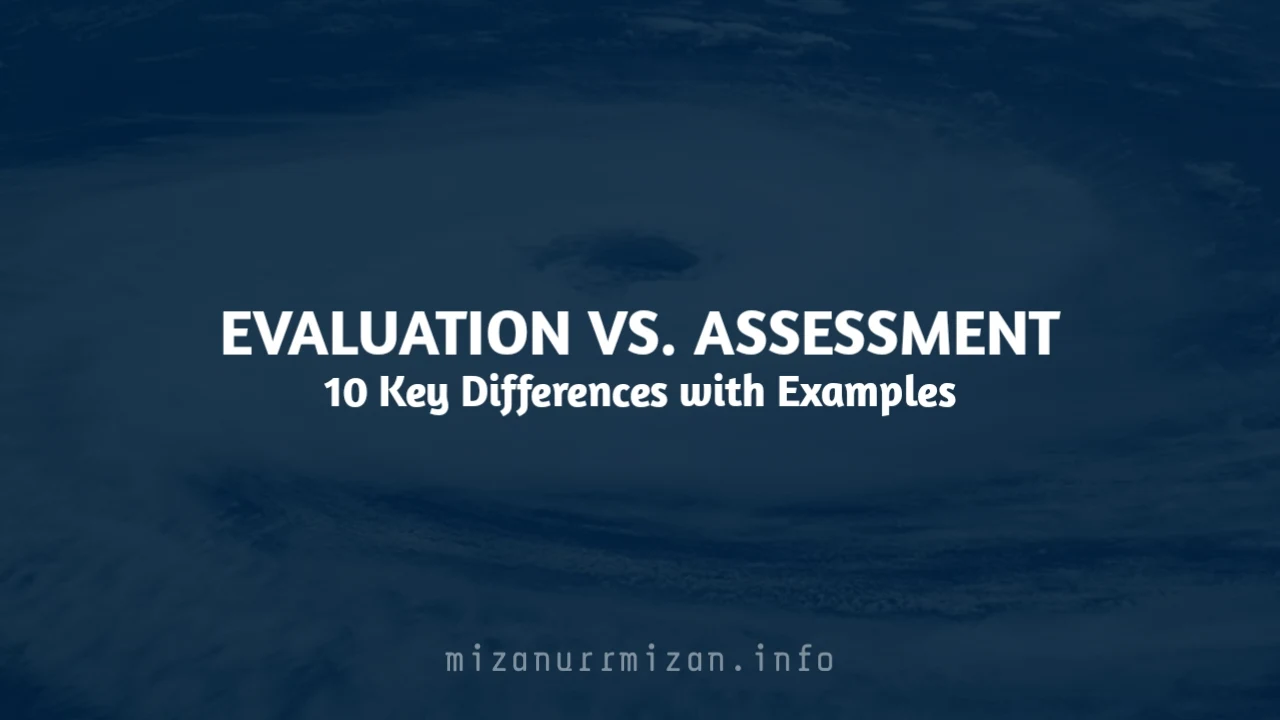In education, two terms—evaluation and assessment—are often used interchangeably, leading to confusion among educators and learners alike. However, a clear understanding of their distinctions is crucial for effective teaching and learning. This article aims to delve into the nuanced disparities between evaluation and assessment in education, elucidating their respective roles, methodologies, and purposes. Through ten illuminating points accompanied by real-world examples, readers will gain a comprehensive grasp of these fundamental concepts, empowering them to navigate the educational terrain with confidence and insight.
1. Nature and Purpose
Evaluation involves making judgments or interpretations based on criteria and standards, often with the aim of determining the worth, quality, or effectiveness of a program, project, or individual's performance. Assessment, on the other hand, focuses on gathering information about learners' knowledge, skills, and abilities to inform instructional decisions and improve learning outcomes.
Example: In a language class, evaluation might entail grading a student's essay based on grammar, coherence, and vocabulary usage. Assessment, meanwhile, could involve administering a pre-test to gauge students' prior knowledge before beginning a new unit on poetry.
2. Timing and Frequency
Evaluation tends to occur at specific points in time, such as the end of a course or academic year, to summarize overall performance and provide feedback for improvement. Assessment is an ongoing process that takes place throughout instruction to monitor progress, diagnose learning needs, and adjust teaching strategies accordingly.
Example: A midterm exam serves as an evaluation tool to assess students' understanding of course material halfway through the semester, while daily quizzes are used for ongoing assessment to gauge comprehension and identify areas requiring reinforcement.
3. Focus and Scope
Evaluation typically addresses broader outcomes or objectives, such as the effectiveness of a curriculum, program, or instructional approach. Assessment targets specific learning objectives or competencies to measure individual student progress and mastery of content.
Example: An evaluation might involve analyzing standardized test scores to assess the overall effectiveness of a district-wide math curriculum. Assessment, on the other hand, might involve assessing students' ability to solve algebraic equations to determine mastery of a particular mathematical concept.
4. Feedback and Reporting
Evaluation often provides summative feedback, offering a retrospective assessment of performance with final grades or ratings. Assessment offers formative feedback, providing ongoing information to guide instructional decisions and support student learning.
Example: A teacher's end-of-year evaluation report might include final grades and comments summarizing students' overall performance. Assessment feedback might involve providing specific comments on individual assignments or conducting one-on-one conferences to discuss areas for improvement.
5. Stakeholders and Audience
Evaluation outcomes are typically intended for external stakeholders, such as administrators, policymakers, or funding agencies, to inform decision-making and resource allocation. Assessment outcomes primarily serve internal stakeholders, including teachers, students, and parents, to enhance teaching and learning processes.
Example: An evaluation report on a school's performance might be presented to the school board or community members to justify funding allocations. Assessment results, such as progress reports or parent-teacher conferences, are shared directly with students and their families to facilitate communication and support academic growth.
6. Methods and Instruments
Evaluation often employs standardized measures, surveys, or rubrics to collect data and make comparisons across individuals or groups. Assessment utilizes a variety of methods, including observations, quizzes, projects, portfolios, and performance tasks, to gather diverse evidence of learning.
Example: A school district might use standardized test scores to evaluate student achievement and compare performance across schools. Classroom assessments might include observations of group discussions, analysis of student work samples, and performance assessments to measure understanding and skill development.
7. Accountability vs. Improvement
Evaluation is often associated with accountability measures, serving to assess compliance with standards, regulations, or performance benchmarks. Assessment is primarily focused on improvement, fostering a culture of continuous learning and growth.
Example: A school may undergo external evaluation by a state education department to ensure compliance with educational standards and regulations. Concurrently, teachers engage in ongoing assessment practices within their classrooms to monitor student progress and adjust instruction to meet individual needs.
8. Objectivity vs. Subjectivity
Evaluation strives for objectivity, utilizing standardized criteria and measures to minimize bias and ensure consistency in judgment. Assessment acknowledges the subjective nature of learning and seeks to gather multiple sources of evidence to capture the complexity of student achievement.
Example: A standardized test is designed to yield objective scores based on predetermined criteria and scoring rubrics. An essay assignment, however, may be subjectively assessed by a teacher who considers not only grammar and spelling but also the depth of analysis and originality of ideas expressed.
9. Consequences and Implications
Evaluation outcomes may have significant consequences, such as determining program funding, accreditation status, or individual advancement. Assessment results inform instructional decisions and provide opportunities for targeted interventions to support student learning.
Example: A low evaluation rating for a school may result in decreased funding or potential closure, impacting students, teachers, and the community. Assessment data indicating a student's struggle with reading comprehension may prompt the implementation of targeted interventions, such as small group instruction or additional support services.
10. Integration and Synergy
Evaluation and assessment are complementary processes that work synergistically to enhance educational effectiveness and promote continuous improvement. By integrating evaluation findings with ongoing assessment data, educators can make informed decisions to optimize teaching and learning outcomes.
Example: A school's evaluation report highlighting areas for improvement in literacy instruction can inform the development of targeted assessment strategies to monitor student progress and assess the effectiveness of instructional interventions. This cyclical process fosters a culture of data-driven decision-making and continuous improvement within educational settings.
Conclusion
In conclusion, while evaluation and assessment are often used interchangeably, they serve distinct purposes in education. Evaluation focuses on making judgments about overall performance and effectiveness, while assessment is an ongoing process of gathering information to support learning and inform instructional decisions. By understanding the nuances of these concepts and their respective roles within the educational landscape, educators can optimize teaching and learning experiences to foster student success and achievement.

